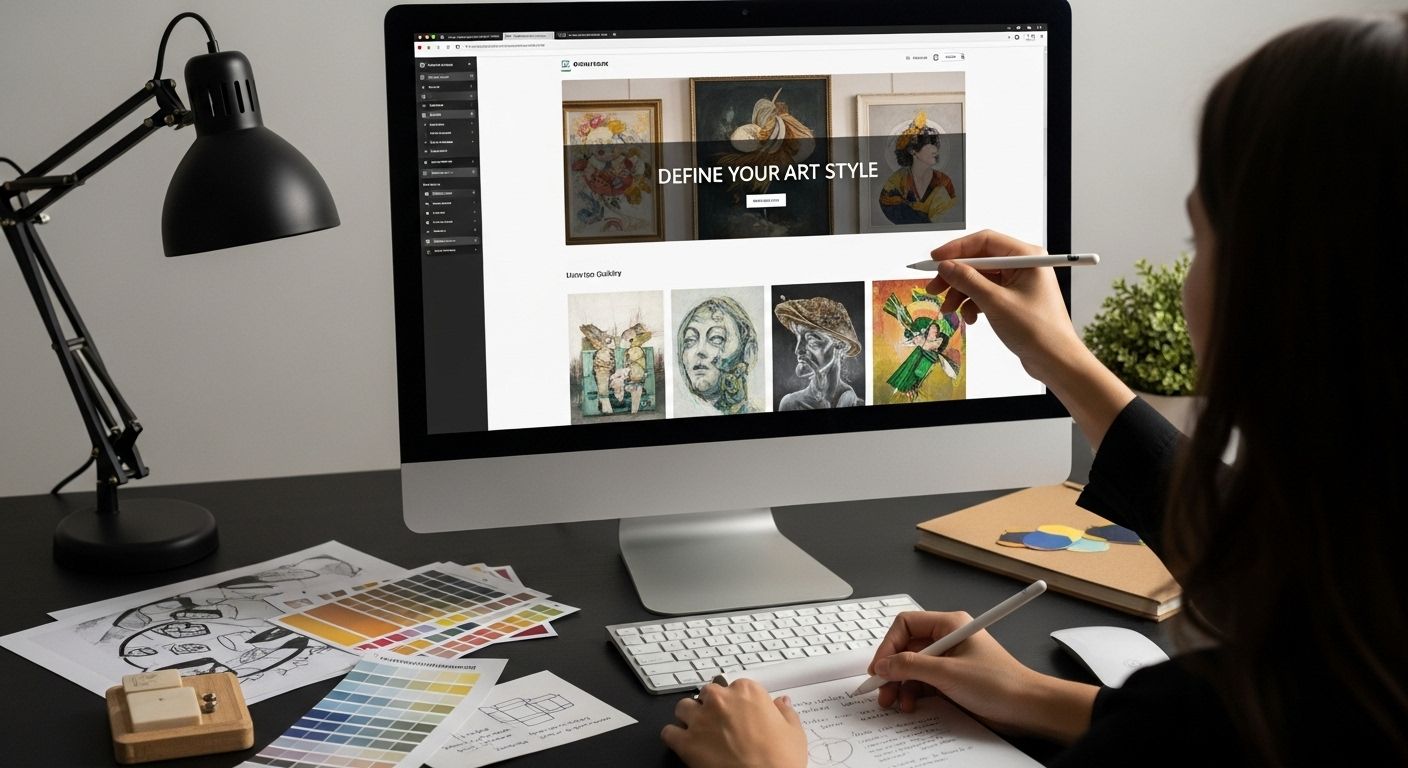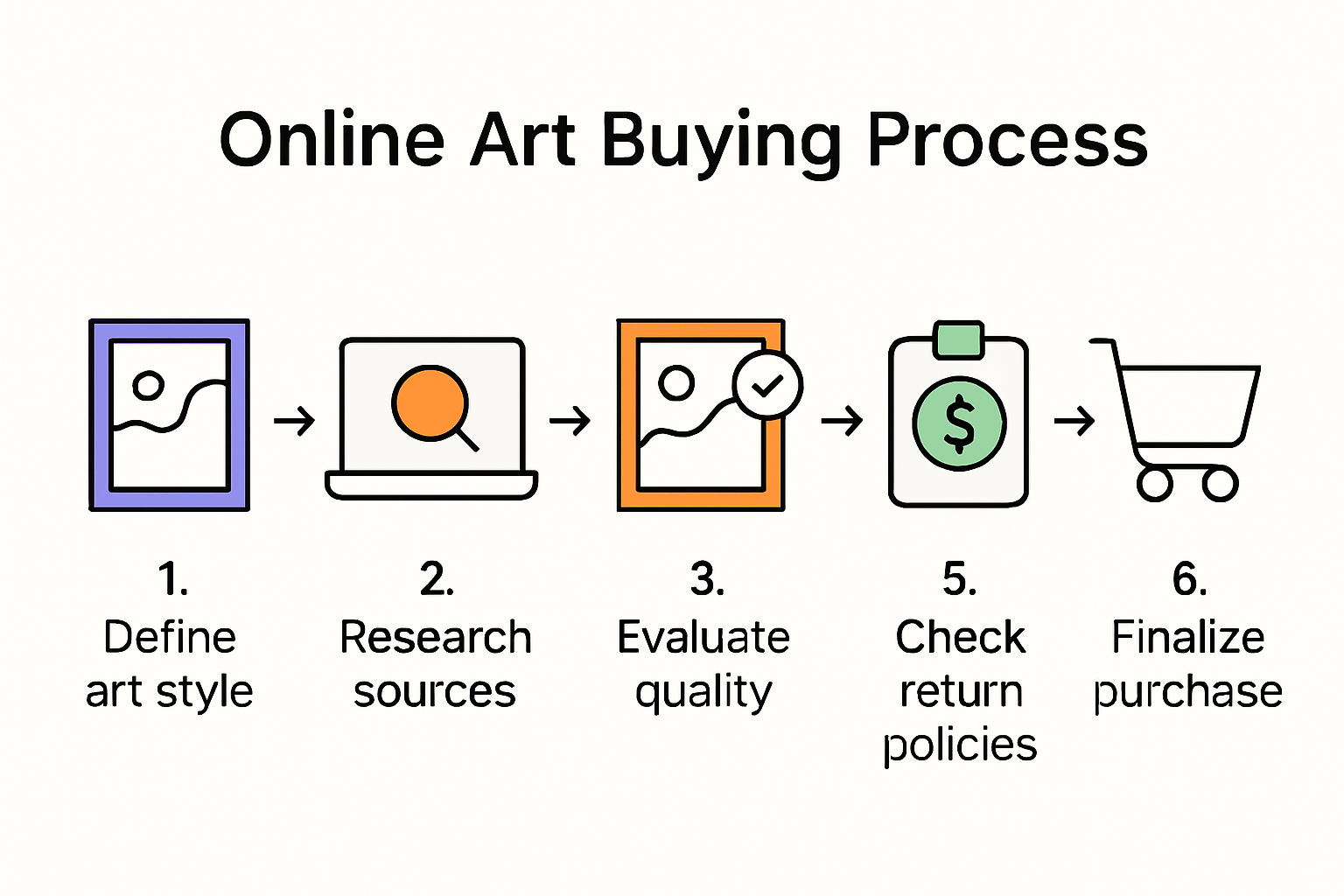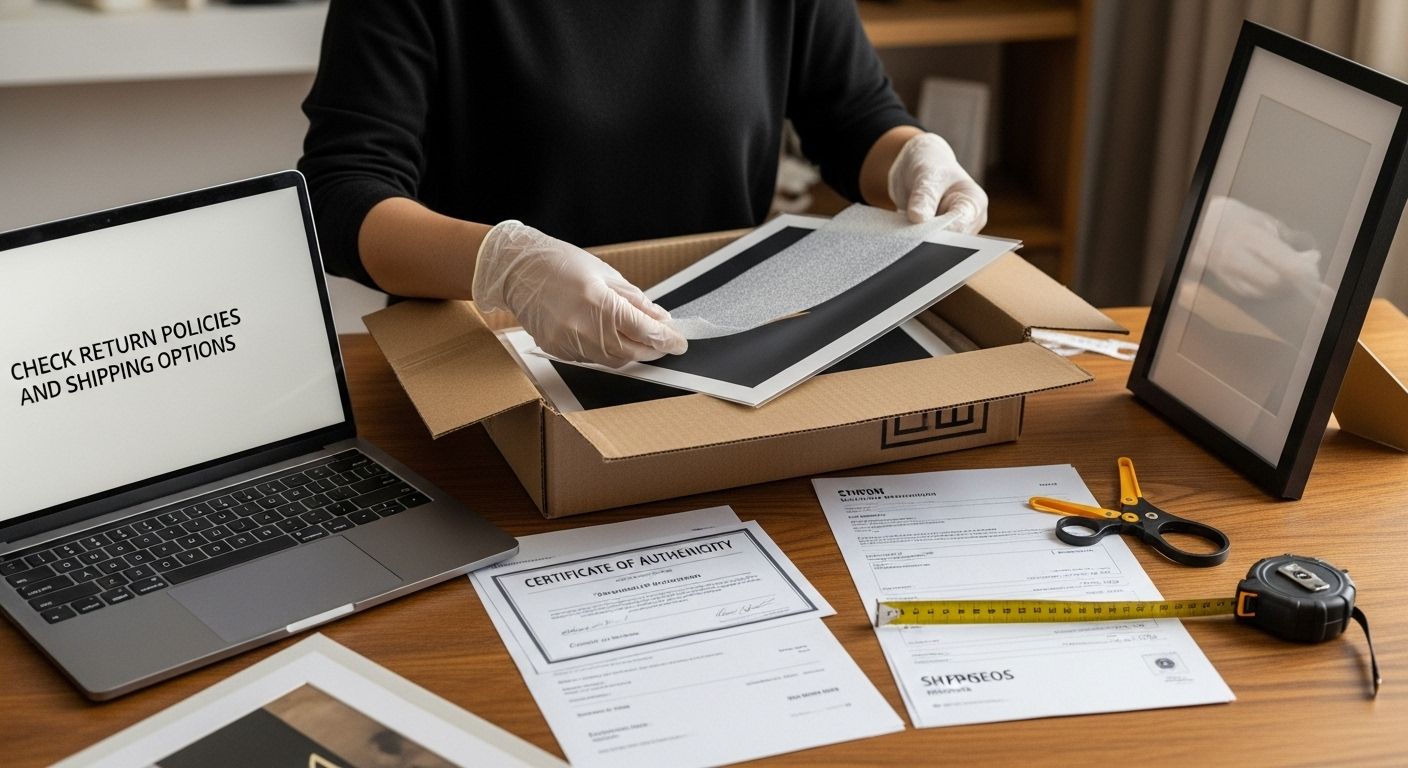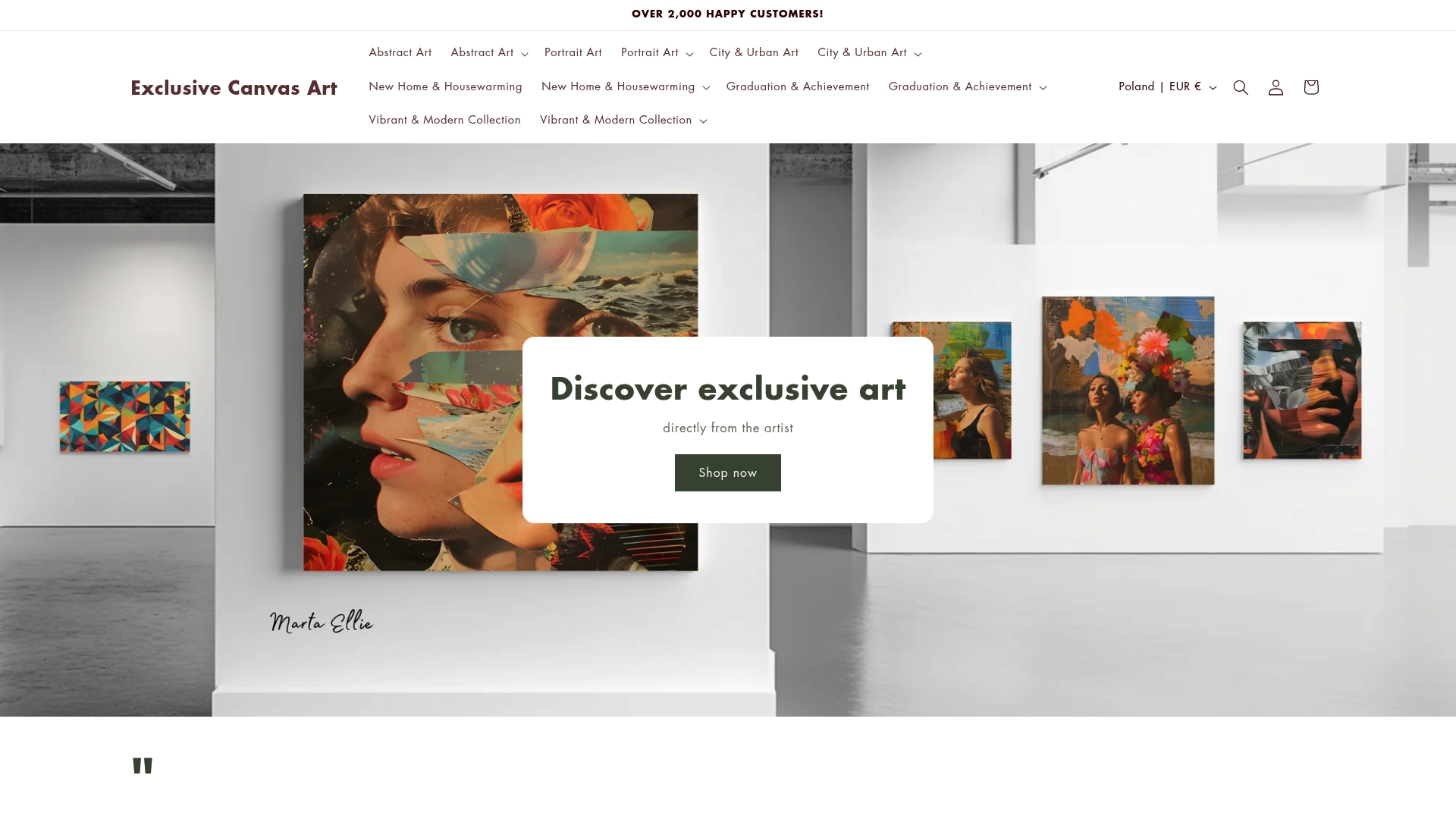
Essential Tips for Online Art Buying in 2025
Picking the right artwork online can feel overwhelming. There are thousands of styles and endless websites promising the perfect piece. But here is the surprise. Research from Caltech shows our art preferences actually follow predictable patterns. This means finding art that feels personal is a lot less random and a lot more doable than you might think.

Table of Contents
- Step 1: Define Your Art Style And Preferences
- Step 2: Research Reputable Online Art Sources
- Step 3: Evaluate The Quality Of Artworks
- Step 4: Set A Realistic Budget For Your Purchase
- Step 5: Check Return Policies And Shipping Options
- Step 6: Finalize Your Purchase And Review Your Choices
Quick Summary
| Key Point | Explanation |
|---|---|
| 1. Define your personal art style | Assess your aesthetic by examining your living space and preferences to identify what resonates with you. |

| 2. Research reputable online art sources | Prioritize platforms with transparent artist information and verification processes to avoid misrepresented artwork. | | 3. Evaluate artwork quality methodically | Review digital representations closely, considering resolution and material specifics to ensure lasting value. | | 4. Set a realistic budget for purchases | Allocate a budget that balances financial responsibility with passion, considering different pricing tiers for art. | | 5. Understand return policies and shipping | Thoroughly read shipping and return guidelines to safeguard your purchase and enhance the buying experience. |
Step 1: Define Your Art Style and Preferences
Starting your online art buying journey requires understanding your personal aesthetic and visual preferences. Art selection is a deeply personal experience that reflects your unique taste, emotional connection, and the atmosphere you want to create in your living or working space. Before clicking through digital galleries or investing in artwork, take time to explore and articulate what truly resonates with you.
Begin by examining the spaces where you plan to display art. Consider the existing color palette, furniture style, and architectural elements. Are your rooms minimalist and modern with clean lines? Or do they feature warm, eclectic designs with rich textures? Your art should complement and enhance your existing environment, creating a harmonious visual narrative.
To systematically define your art style, consider conducting a visual inventory of images that excite you. Use platforms like Pinterest or Instagram to create mood boards, collecting artwork that sparks an emotional response. Look for patterns in your selections: Do you gravitate towards abstract expressionism, photorealistic landscapes, or urban street art? Pay attention to color schemes, artistic techniques, and emotional tones that consistently attract your eye.
Explore our curated art themes guide to help refine your artistic preferences. The computational research suggests that individual art tastes can be systematically understood, with studies from Caltech demonstrating that personal preferences follow predictable patterns.
Don’t limit yourself to a single genre. Successful art collectors often develop versatile, nuanced tastes that incorporate multiple styles. Allow yourself to be surprised by unexpected pieces that challenge your initial perceptions. Ultimately, the art you choose should spark joy, provoke thought, or create an emotional connection that transforms your space beyond mere decoration.
Step 2: Research Reputable Online Art Sources
Transitioning from understanding your art style to finding credible online sources requires strategic navigation through the digital art landscape. Not all online art platforms are created equal, and discerning buyers must develop a keen eye for distinguishing reputable marketplaces from questionable websites.
Start by prioritizing platforms with transparent artist information, detailed artwork provenance, and robust verification processes. Look for websites that provide comprehensive artist backgrounds, clear copyright information, and high-resolution images that allow close examination of artwork details. Professional online art galleries will offer multiple viewing angles, precise measurements, and accurate color representations to help you make informed purchasing decisions.
Authenticity is paramount when exploring online art sources. Seek platforms that feature verifiable artist credentials, professional portfolios, and clear return policies. Professional art websites often collaborate directly with artists or curate collections from established creators, ensuring the quality and legitimacy of their offerings. Learn more about evaluating art quality to refine your selection process.
As recommended by academic research from Cal Poly Humboldt’s Art Research Guide, evaluate online art sources by examining their domain credibility. Websites with .edu, .org, or verified professional domains often indicate more reliable and curated art collections. Pay attention to the website’s ‘About’ section, artist credentials, and user reviews to gauge the platform’s reputation.
Develop a systematic approach to vetting online art sources. Cross-reference artist information across multiple platforms, check for professional memberships, exhibition histories, and social media presence. Remember that reputable online art sources are transparent, provide detailed artwork information, and prioritize artist representation. Your diligence in research will significantly reduce the risk of purchasing inauthentic or misrepresented artwork.
To help you evaluate potential online art platforms more efficiently, here is a checklist table summarizing the key questions and factors to verify before making a purchase:
| Verification Step | What to Look For | Why It Matters |
|---|---|---|
| Artist information transparency | Comprehensive artist backgrounds | Confirms authenticity |
| Provenance and copyright details | Clear and verifiable documentation | Ensures artwork legitimacy |
| High-resolution images | Multiple angles, zoom, accurate colors | Allows close inspection |
| Return policy clarity | Specific return windows and conditions | Protects you if unsatisfied |
| Shipping protection and insurance | Secure packaging, tracking, insurance | Prevents damage and loss |
| Domain credibility and reviews | .edu, .org domains; positive user feedback | Signals platform reliability |
| Artist credentials and portfolios | Memberships, exhibitions, social links | Confirms artist’s professional status |
Step 3: Evaluate the Quality of Artworks
Evaluating artwork quality goes far beyond aesthetic appeal, requiring a nuanced approach that combines technical understanding and intuitive appreciation. Digital art buying demands careful, systematic assessment to ensure you invest in pieces that are both visually compelling and structurally sound.
Begin by examining the digital representation of the artwork with a critical eye. High-quality online platforms will provide multiple viewing angles, allowing you to zoom in and inspect intricate details. Pay close attention to resolution, color accuracy, and texture representation. Look for images that demonstrate crisp lines, consistent color gradation, and clear representation of the original artwork’s material characteristics. Blurry, pixelated, or overly compressed images are immediate red flags indicating potential quality issues.
Material and production specifications become crucial in your evaluation process. Professional artists and reputable galleries will provide comprehensive details about the artwork’s creation, including the type of canvas, printing technique, and archival qualities. Discover expert insights on art quality assessment to refine your understanding of these technical nuances.
Authenticity verification represents another critical dimension of artwork evaluation. Request or research documentation that confirms the artwork’s origin, including artist signatures, edition numbers for limited prints, and certificates of authenticity. Professional artists and galleries typically provide comprehensive provenance information that establishes the artwork’s legitimacy and potential future value.
Consider the artwork’s preservation potential and long-term visual integrity. Archival-quality prints use fade-resistant inks and premium materials that maintain color vibrancy and structural integrity for decades. Request specific information about the printing process, ink type, and expected longevity. Reputable art sources will transparently share technical specifications that demonstrate their commitment to delivering high-quality, enduring art pieces that will continue to inspire and enhance your space for years to come.
Step 4: Set a Realistic Budget for Your Purchase
Budgeting for art requires a delicate balance between financial responsibility and artistic passion. Your budget is more than a monetary constraint - it’s a strategic framework that guides your art collecting journey while protecting your financial well-being. Begin by conducting a comprehensive assessment of your discretionary income, understanding that art purchasing should never compromise your essential financial obligations.
Establish a clear budget range that reflects both your financial capacity and artistic aspirations. Consider breaking your art budget into tiers: entry-level purchases for emerging artists, mid-range investments for established creators, and premium allocations for exceptional pieces that truly resonate with your aesthetic vision. Experienced art collectors recommend dedicating no more than 10% of your discretionary income to art purchases, ensuring your passion remains sustainable and enjoyable.
Digital art marketplaces offer unprecedented flexibility in pricing, presenting opportunities for collectors at every financial level. Take advantage of platforms that provide price filtering, allowing you to explore artwork within your predetermined budget range. Some online galleries offer flexible payment options like installment plans, which can make more expensive pieces more accessible without straining your financial resources.
Explore our collector’s budgeting strategies to refine your approach to art investment. Remember that the value of art extends beyond its price tag. Consider factors like emotional connection, potential appreciation, and the artwork’s ability to transform your living space. A modestly priced piece that speaks to you can be far more valuable than an expensive work that fails to inspire.
Develop a systematic approach to art budgeting by tracking your purchases, maintaining a dedicated art investment fund, and continuously educating yourself about market trends. Your budget should remain flexible, allowing for unexpected opportunities while maintaining fiscal discipline. Ultimately, successful art collecting is about creating a meaningful collection that reflects your personal aesthetic and financial comfort zone.
Step 5: Check Return Policies and Shipping Options
Navigating the logistics of online art purchasing requires careful attention to return policies and shipping arrangements. These critical details can make or break your art buying experience, transforming a potential disappointment into a smooth, confidence-building transaction. Before finalizing any artwork purchase, invest time in thoroughly understanding the platform’s shipping and return guidelines.
Begin by meticulously reviewing the return policy of your chosen art platform. Professional online galleries will offer transparent, comprehensive return guidelines that outline exactly what conditions must be met for a potential return. Look for policies that provide a reasonable window for returns - typically 14 to 30 days from receipt. Pay close attention to specific conditions, such as the artwork needing to be in its original condition, with original packaging intact, and unaltered in any way.
Shipping considerations become equally important when purchasing art online. Examine the platform’s shipping options, looking for services that provide comprehensive protection for delicate artworks. Reputable art sellers will offer specialized art shipping methods that include secure packaging, insurance, and tracking capabilities. Consider the shipping costs, estimated delivery times, and whether the platform provides international shipping if you’re purchasing from a global marketplace.
Learn more about art shipping strategies to protect your investment. According to The Metropolitan Museum of Art Store’s shipping policy, professional art platforms typically provide detailed information about handling, packaging, and potential additional fees for specialized art transportation.
Develop a systematic approach to reviewing shipping and return policies. Create a checklist that includes key questions: What are the exact return conditions? Who covers return shipping costs? How are fragile artworks packaged and insured? Are there additional fees for international shipping? Your diligence in this step will help prevent potential disappointments and ensure a smooth, enjoyable art purchasing experience that protects both your financial investment and artistic vision.

Step 6: Finalize Your Purchase and Review Your Choices
The final stage of online art buying demands a methodical approach that combines emotional satisfaction with practical decision-making. Purchasing art is more than a transaction - it’s a personal investment that requires careful, thoughtful consideration before clicking the final ‘purchase’ button.
Before completing your transaction, conduct a comprehensive final review of your selected artwork. Zoom in on digital images, examining every detail with the same scrutiny you would apply in a physical gallery. Verify that the artwork precisely matches your initial vision and aesthetic preferences. Check the dimensions carefully, ensuring the piece will fit perfectly in your intended space. Many online art buyers make the mistake of overlooking scale, only to discover the artwork is dramatically different from their expectations upon arrival.
Financial and documentation preparation becomes crucial in this concluding stage. Create a dedicated digital folder to store all purchase-related documentation, including high-resolution images of the artwork, purchase receipts, shipping confirmations, and any certificates of authenticity. Explore our collector’s documentation guide to streamline your record-keeping process.
According to The Smithsonian American Art Museum’s recommendations, maintaining comprehensive records serves multiple purposes. These documents protect your investment, assist with potential insurance claims, and create a personal archive that documents your evolving art collection. Professional collectors treat each artwork purchase as part of a larger, curated narrative.
Take a moment for introspective reflection before finalizing the purchase. Ask yourself critical questions: Does this artwork genuinely spark joy? Will it continue to inspire you years from now? Does it align with your budget and long-term collecting strategy? Your most successful art acquisitions will emerge from purchases that resonate deeply with your personal aesthetic and emotional landscape, transcending mere visual decoration to become meaningful expressions of your individual taste and journey.
Here is a checklist table to guide you through verifying and preparing your artwork purchase before finalizing the transaction:
| Final Review Step | Description | Related Action |
|---|---|---|
| Zoom in on artwork images | Inspect for quality, detail, and accuracy | Confirm matches expectations |
| Verify artwork dimensions | Check size to ensure proper fit in intended space | Measure intended display area |
| Document purchase information | Save receipts, certificates, images, confirmations | Create a digital records folder |
| Review return/shipping policies | Re-read policies to be clear on all terms | Note return window and fees |
| Reflection on purchase | Ask if the piece sparks joy and meets your criteria | Pause before finalizing |
Bring Your Online Art Buying Tips to Life with Marta Ellie’s Curated Collections
You have just learned how crucial it is to trust reputable sources, choose art that resonates with your style, and ensure quality in every piece before making that final purchase. But are you still facing uncertainty about where to find art that truly fits your taste while guaranteeing authenticity and a smooth buying experience? Marta Ellie’s platform bridges these gaps for you. Whether you seek vibrant expression, unique fantasy, or celebration-themed pieces, our handpicked works in the Fantasy Art Collection - Digital & Traditional Artwork and Moving Day Celebration Art Under $400 are backed by thorough provenance details and artist insights. Here you confidently select the perfect artwork that matches your defined style and desired price point.

Give your space an upgrade and put these essential buying tips into action right now. Visit MartaEllie.com to explore complete collections, learn more about each piece, and experience a seamless purchase process. Create a gallery-worthy environment in your home and shop with assurance today.
Frequently Asked Questions
How do I determine my personal art style?
Understanding your personal art style starts with examining your emotional responses to various artworks. Create mood boards using platforms like Pinterest or Instagram to identify patterns in color, technique, and subject matter that resonate with you.
What should I look for in reputable online art sources?
When researching online art sources, prioritize platforms that provide transparent artist information, detailed provenance, and high-resolution images. Consider checking for user reviews and verification processes to ensure the authenticity and quality of the artwork.
How can I evaluate the quality of an artwork online?
To evaluate artwork quality, closely inspect high-resolution images for detail and color accuracy. Look for material specifications, artist credentials, and verification documentation such as certificates of authenticity. These elements indicate the artwork’s quality and legitimacy.
What factors should I consider when setting a budget for art purchases?
When budgeting for art, assess your discretionary income and set a clear range that reflects both financial capacity and artistic goals. It may help to categorize purchases by price tiers and remember to keep your budget flexible to accommodate unexpected opportunities.
Recommended
- Top Tips for Buying Art Gifts: Modern Ideas for 2025 – Exclusive Canvas Art
- Preserving Canvas Artwork: Best Tips for Art Lovers 2025 – Exclusive Canvas Art
- How to Store Art Safely: Protect Your Wall Art and Canvas in 2025 – Exclusive Canvas Art
- Protecting Canvas Art: Essential Tips for 2025 Walls – Exclusive Canvas Art
- Buying Art for Investment in South Africa: 2025 Guide - Art-Online
- 🎨 Mastering the Art - Best Practices for Visual Artist Portfolios | Effortlessly Professional Websites